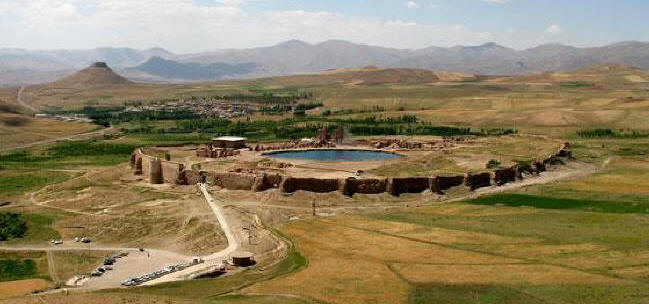The Takht-e-Soleyman Complex
Takht-e-Soleyman is a UNESCO-listed World Heritage site which includes a natural lake, a collection of ancient buildings, the Dragon Stone (Sang-e- Eghdeha) and Zendan-e-Soleyman Mountain (Figure 5.3).The oldest buildings date back to the first millennium BC, and the most important one is the Azargoshab Fire Temple which, based on historical records, is considered to be Zoroaster’s birthplace. The lake is in fact a large perennial travertine spring taking its water from deep below the earth’s surface. It has an oval shape with diameter of up to 115 m and a depth of between 50 and 70 m. Travertine deposits have made a large plate, 20 m high, around the lake, on which ancient buildings are situated, and the lake is located in its centre. The water flows downward through a few streams and has led to the formation of a structure that is called Sang-e-Eghdeha.This is a long, spiral wall made of early travertine deposits, and it has gradually increased to its current height of 1.5 m. Around the main site there are other hot water and travertine springs, some of which are used for bathing and water therapy by both local people and tourists. There is another phenomenon in this complex, 2 km away from the main site, named Zendan-e-Soleyman, which is a cone-shaped mountain. This is the remnant of a former large travertine spring, and a rupture in the walls (the result of a fault) has been created by water drainage from the lake now becoming inactive.The view of the inner side of the hollow mountain gives rise to the mountain called Zendan-e-Soleyman (Prison Mountain).

Alireza Amrikazemi & Abbas Mehrpooya
Ross Dowling, David Newsome (2006). Geotourism, Publishe by Elsevier, PP 87.